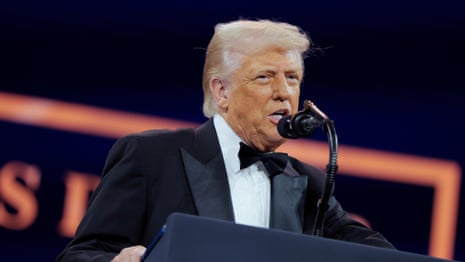The American vice-president, JD Vance, arrived in India for interviews with the Prime Minister, Narendra Modi, on a bilateral trade agreement while the American tariff war with China degenerates and the frightened US global economic alliances.
Vance, joined by the second lady, Usha Vance, and their three children, Ewan, Vivek and Mirabel, landed in Delhi on Monday for a four -day visit that mixes high -level negotiations with a family tourist visit. The Vance family was welcomed to the airport by the Minister of Railways Ashwini Vahnaw. They stood under a red canopy which protected them from the flamboyant sun while the soldiers stood in salvation and that a military group played the American anthem.
The White House described the visit as focused on “shared economic and geopolitical priorities”, while India said that Vance’s stay “would offer both parties to review the progress of bilateral relations”.
The talks will focus on the Jet-Suivi of a commercial pact in the middle of the Washington World Tariff’s offensive, even though farmers and tensions of farmers on American immigration threaten to overshadow the trip.
India was struck with 26% of Donald Trump prices on April 2 despite his good relations with Modi. A 90 -day break offered temporary relief, but Delhi remains suspicious.
To browse new economic benefits, officials of the Indian capital have made overtime to hammer the first tranche of the trade agreement that the two parties hope to have finished in the fall. India has already reduced prices on certain American products and other scanning cuts are expected.
The United States is the best trading partner in India, with two-way trade exceeding $ 190 billion (144 billion pounds sterling). This relationship was stimulated after Modi made a goodwill visit to Washington after Trump’s return to the White House. The two leaders are committed to more than a bilateral double exchange at $ 500 billion – a “mega partnership”, as Modi called it.
But not everyone is happy. On April 21, the day of the arrival of Vance, the largest and oldest union of the farmers in India, the All India Kisan Sabha (AIKS), called for national demonstrations to oppose a trade agreement. The union says that trade liberalization could devastate agricultural income, in particular in the dairy sector.
The AIK, affiliated with the Communist Party of India, claim more than 16 million members and accused the American secretary to trade, Howard Lungick, of “coercion” to demand that the strongly subsidized agricultural sector of India is part of the agreement.
Meanwhile, memories are still fresh in the Modi government demonstrations of large-scale farmers in 2020-20121 which forced the repeal of controversial farmers.
Tensions also move away from student visas and H-1B, often awarded to technological workers. The head of Congress Jairam Ramesh reported American data showing that out of 327 revocations of recent visas for international students, half involved by Indian nationals.
“The reasons for the revocation are random and unclear. There is increasing fear and apprehension,” said Ramesh, urging the Minister of Affairs outside the concern “in the United States.
The American Immigration Lawyers Association says that US immigration officials “aggressively aim for international students”, including those who have no history of protest.
The concerns about H-1B visas, long vital for Indian technology workers in the United States, are also riding. The Indians represented 70% of all H-1B visas last year, more than 200,000. Uncertainty about profitability encourages a lot to cancel home visits.
The spokesman for the Ministry of External Affairs, Randhir Jaiswal, said that the government was “very positive” that Vance’s visit “stimulates” links and would promise “all relevant questions”.
The time of Vance as vice-president was marked by his foreign policy “America First”. During a European tour, he raised Tempers by criticizing the defense expenses of the allies. In March, during a stop of Greenland, he caused dismay by saying: “We must have Greenland. It is not a question of” Do you think we can do without it? “”
Vance in India is visited just after the head of the US intelligence chief Tulsi Gabbard was in Delhi to strengthen the quad – the security group of the four countries of the United States, India, Japan and Australia – considered a counterweight to the growing weight of China.
Xi Jinping, the Chinese president, was also on a charming offensive in Southeast Asia, promoting Beijing as a more stable and reliable economic ally than Washington.
Although Vance is mainly visiting, his trip will have a strong personal element. The family will visit the royal palaces of Jaipur and the emblematic Taj Mahal. Managers say that the “private component” highlights the Indian roots of Usha Vance – it was born in the United States of Indian immigrants – and deep ties with India.


